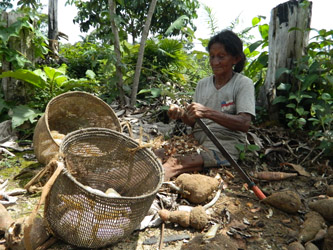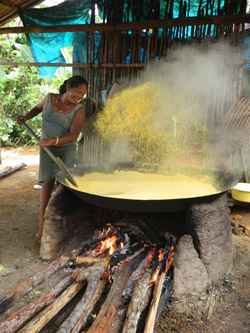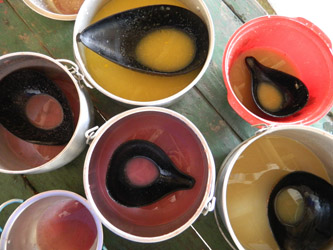Fieldwork in Northwest Amazonia
Powerful women: Food Production and Construction of Personhood among the Tukanoan Indians of Northwest Amazonia.
Phd student, Social Anthropology, Universidade Federal de Santa Catarina, Brasil and visiting student, Division of Social Anthropology, University of Cambridge.


 My PhD research focuses on processes of construction of personhood and social transformations among the Tukanoan indians of the Tiquié river, Upper Rio Negro, Northwest Amazonia, Brasil. The Tukanoan are divided in nineteen exogamous patrilinear descent groups distributed in the Uaupés and Pirá Paraná basins, border of Brasil and Colombia. I have been working in this region since 2005 and my specific PhD fieldwork was accomplished between April, 2012 and May, 2013, in three Tukano villages of middle Tiquié river.
My PhD research focuses on processes of construction of personhood and social transformations among the Tukanoan indians of the Tiquié river, Upper Rio Negro, Northwest Amazonia, Brasil. The Tukanoan are divided in nineteen exogamous patrilinear descent groups distributed in the Uaupés and Pirá Paraná basins, border of Brasil and Colombia. I have been working in this region since 2005 and my specific PhD fieldwork was accomplished between April, 2012 and May, 2013, in three Tukano villages of middle Tiquié river.
Men and women have complementary roles in the construction of Tukanoan personhood: male shamanism and female production of food (Hugh-Jones, C.1979), the latter being the subject of the photographs. Besides all the social transformations that happened in Upper Rio Negro since the XVIII century (due to the contact with slave raiders, traders, rubber gathers, missionaries, miners and government policies), local food, essentially manioc (Manihot esculenta)products and fish, continue to be central in the feeding habits and tastes of Tiquié dwellers. Women have the fundamental role of cultivating and processing the bitter manioc and preparing diverse kinds of food and drinks.
But some transformations can be noted through generations: young student women spend less time helping their mothers with the gardening; with increasing monetarization (ie paid jobs and governments benefits) the introduction of industrial food is growing. Some salaried younger couples dedicate less time to clearing and cultivating manioc gardens but in order to meet their demands for manioc products, they exchange city commodities with the women village manioc producers.
In the first photograph (top right) Palmira, a Desana woman, is working on manioc tubers (Kii) in her own garden (wehse) in Wahpu nuhku village, middle Tiquié river. The Tukanoan marriage system is based on linguistic exogamy and patrilocal residence, so that after the marriage the women go to live in their husband’s village among people of another Tukanoan group. Her husband will open a clearing for her and she will cultivate her own manioc garden. Manioc gardening is quintessentially the feminine domain.
In the second, Silvia, a Tukano woman, is producing farinha (poka) in Bote purῖ bua village, middle Tiquié river. Women spent the most time of their day cultivating, processing manioc, and producing drink and food derived from it. The production of farinha takes several hours. Besides being consumed in the village, it is often also exchanged by women with white or caboclo traders and salaried Indians for commodities, such as saucepans, sandals and clothes.
Lastly (bottom right), Manioc farinha porridges (ñumuko) are mixed with different palm tree fruits (bacaba, Oenocarpus bacaba and açaí, Euterpe oleracea). Produced by women during the seasonal fruit period, it provides the village with the daily communal meals in a variety of special colours and tastes. In this region, the variety of meals is based on a very specific ecological calendar.
Bibliographical reference: Hugh-Jones, C. From the milk river: Spatial and temporal processes in Northwest Amazonia. Cambridge University press, 1979.
